
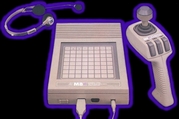
  |
|
|
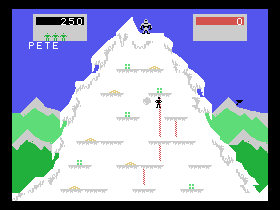
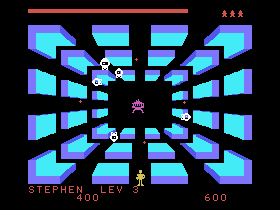 |
Probably most of you that come across this page have absolutely no idea as to what the MBX Gaming Expansion is, mainly due to the lack of good information available on the Internet for this device. However, the MBX offered so much to gamers back when it was introduced to the public in late 1983 that it only made sense to devote a whole section to it on the TI-99/4A Videogame House. The MBX itself came out around September 1983 and was discontinued shortly thereafter due to the infamous Video Game Crash of 1984. As far as can be determined from the "Control Number" stickers that were placed on the sides of MBX boxes and units, the MBX was manufactured from September - November 1983 (MB8309-MB8311). If anyone out there can confirm a control number earlier or later than the range given above, e-mail us as it would be very helpful to determining exactly how long these systems were in production for! What makes the MBX stand out from other video gaming add-ons (such the Colecovision Driving Controller) is the wide array of special features it brings to the table. The system itself provides 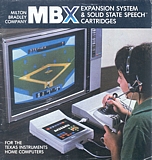 the
player with an Action-Input Keypad, Speech Synthesis, Voice Recognition, and also the
ability to use 360°
Analog Joysticks (you can read more
about all these features in the other sections on this page). But, it
was
the voice recognition capabilities that made the MBX truly stand out,
since it added a totally
new dimension to game playing that most other systems did not have. One
important thing to mention is the fact that the MBX could not be used
with regular TI-99/4A cartridges, instead cartridges that were
specifically produced for the MBX unit by Milton Bradley were required.
These games were sold separately and provided some of the best
video gaming action available on the TI-99/4A (an incomplete listing
of these cartridges can be found in the "MBX Cartridges" section).
This device was truly ahead of its time when released and is a must
have
for any classic video game collector/player! the
player with an Action-Input Keypad, Speech Synthesis, Voice Recognition, and also the
ability to use 360°
Analog Joysticks (you can read more
about all these features in the other sections on this page). But, it
was
the voice recognition capabilities that made the MBX truly stand out,
since it added a totally
new dimension to game playing that most other systems did not have. One
important thing to mention is the fact that the MBX could not be used
with regular TI-99/4A cartridges, instead cartridges that were
specifically produced for the MBX unit by Milton Bradley were required.
These games were sold separately and provided some of the best
video gaming action available on the TI-99/4A (an incomplete listing
of these cartridges can be found in the "MBX Cartridges" section).
This device was truly ahead of its time when released and is a must
have
for any classic video game collector/player!Now that you have an idea as to what the MBX System is, below is a little history provided by Mike Langieri (the creator of the device). According to Mike, the MBX actually started out as a stand-alone game console in 1982 and was 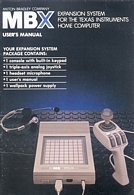 to be Milton Bradley's answer to the Atari 2600 and Intellivision. MB's
plan was to provide the game player with voice recognition, speech
synthesis, and an action-input keypad which in turn would give them an
advantage over the systems already on the market. Now how come MB
did not go
ahead with their own system in 1982? The answer to this lies in the
Colecovision
(seems as if the Colecovision was not only connected to the TI-99/4A
since they both used the same graphics chip, but also because
without Coleco putting a video game system out in 1982 there never
would have been an MBX!). Once the Colecovision came out, Jim Shea
(then president of Milton Bradley) thought that the market was not big
enough to support 4 game systems from Atari, Mattel, Coleco, and Milton
Bradley and therefore killed the project. However, so much development
went into creating MB's own video game unit that Mike was then
assigned to finding a use for all the technology they developed.
Eventually it was decided to transform Milton Bradley's gaming system
to an add-on for the TI-99/4A, most likely due to the fact that MB had
earlier developed the Gamevision line of video games for the 99/4A and
also created the graphics chip used inside of the TI system. Thus, "the
MBX was
the phoenix that rose from the ashes" as Mike wonderfully put it.
to be Milton Bradley's answer to the Atari 2600 and Intellivision. MB's
plan was to provide the game player with voice recognition, speech
synthesis, and an action-input keypad which in turn would give them an
advantage over the systems already on the market. Now how come MB
did not go
ahead with their own system in 1982? The answer to this lies in the
Colecovision
(seems as if the Colecovision was not only connected to the TI-99/4A
since they both used the same graphics chip, but also because
without Coleco putting a video game system out in 1982 there never
would have been an MBX!). Once the Colecovision came out, Jim Shea
(then president of Milton Bradley) thought that the market was not big
enough to support 4 game systems from Atari, Mattel, Coleco, and Milton
Bradley and therefore killed the project. However, so much development
went into creating MB's own video game unit that Mike was then
assigned to finding a use for all the technology they developed.
Eventually it was decided to transform Milton Bradley's gaming system
to an add-on for the TI-99/4A, most likely due to the fact that MB had
earlier developed the Gamevision line of video games for the 99/4A and
also created the graphics chip used inside of the TI system. Thus, "the
MBX was
the phoenix that rose from the ashes" as Mike wonderfully put it.After the switch was made to develop the MBX for the TI-99/4A, Mike Langieri designed the wonderful MBX Joysticks in addition to a number of game titles (Championship Baseball, Bigfoot, Space Bandits, and Terry Turtle's Adventure). According to Mike, "Dave [Winzler] and I worked our butts off making [Championship Baseball] the showcase game for the MBX and perhaps the product we needed to break into the business". After Championship Baseball 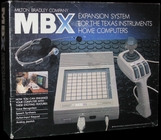 was completed
along with a number of other titles in 1982, the
MBX and its games were demoed at the
January 1983 CES show. Mike recalled this
great image during one of the CES demos, "I was demonstrating
the MBX in a glass enclosed booth, and we actually had lines of people
waiting to get in to see it". The image of long lines waiting to see
the
MBX shows just how impressive the system really was, and apparently
there were some high profile companies waiting to get a glimpse of it.
Sometime after the
January CES show, Mike flew out to Atari to
give them a viewing as to what was coming on the market. Atari
was so impressed by the product that they decided to enter into an
agreement with Milton Bradley, where MB would produce an equivalent
system for their
2600 and 5200 gaming consoles called the Voice Commander (more on the
Voice Commander story and the eventual suit MB filed against Atari can
be read about here in
the last paragraph of the page). was completed
along with a number of other titles in 1982, the
MBX and its games were demoed at the
January 1983 CES show. Mike recalled this
great image during one of the CES demos, "I was demonstrating
the MBX in a glass enclosed booth, and we actually had lines of people
waiting to get in to see it". The image of long lines waiting to see
the
MBX shows just how impressive the system really was, and apparently
there were some high profile companies waiting to get a glimpse of it.
Sometime after the
January CES show, Mike flew out to Atari to
give them a viewing as to what was coming on the market. Atari
was so impressed by the product that they decided to enter into an
agreement with Milton Bradley, where MB would produce an equivalent
system for their
2600 and 5200 gaming consoles called the Voice Commander (more on the
Voice Commander story and the eventual suit MB filed against Atari can
be read about here in
the last paragraph of the page).By April 1983, when the MBX initially was supposed to be released to the public, Milton Bradley came out with news that there were some delays and the MBX would not be available until later that year. The most likely explanation for this delay was the fact that TI was in the process of changing the color scheme of the TI-99/4A consoles from black/silver to beige. Considering that the MBX systems shown at the January CES were housed in black/silver cases, which at the time matched the current TI-99/4A color scheme, Milton Bradley probably wanted to make sure that at the time of release the MBX and TI consoles matched. Therefore, MB decided to delay the release of the system. By the time the MBX did come to market in September, it was not just in a new beige color but also was completely redesigned to closer match the new design of the TI-99/4A. In hindsight, it's too bad Milton Bradley did not release the MBX earlier as the video game crash of 1984 put an early end to this great gaming system. How the MBX got to be what it was is truly an amazing and interesting story. It's also very interesting to know that when you are playing games with the MBX on the TI-99/4A, you actually are looking at what was to be Milton Bradley's answer to the Atari 2600 and Mattel Intellivision. If you are into classic gaming check out the MBX not just because of all its features and great games, but also because you can see what could have been Atari's next competitor! This unit is the core of MBX gaming and where all of the special capabilities come together. When Milton Bradley made the MBX they decided to have it basically take the place of the TI-99/4A, since the MBX Headset and Joysticks plug directly into this device instead of the TI console as normally would be the case. But besides simply acting as a fancy interface for all the various gaming devices to plug into, the MBX system also has some unique 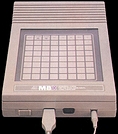 features built into it. The first feature that it
comes equipped with is a speech synthesizer which outputs speech
from a speaker located on the top of the device. Now at this point
you're probably saying, "okay so
the MBX has a built in speech synthesizer. But what makes that
different from running a TI-99/4A with the separate speech
synthesizer plug-in attached?" The answer lies in the fact that the
speech
synthesizer built into the MBX is actually better than the one sold by
TI as an add-on. One play of some game cartridges quickly reveals this
difference, as the voices generated during game play sound better and
even more
realistic on the MBX than playing them with the TI speech synthesizer
(Try experimenting for yourself. If you play the MBX game Bigfoot with
the MBX system attached, the in-game speech will actually sound much
better than when playing Bigfoot with TI's speech add-on attached). The
speech
offered by the MBX was truly advanced for 1983 and sometimes the
synthesized voices are actually hard to tell apart from a real human's!
The
best
example of this comes right when you turn on the MBX and a
realistic female voice comes out of the speakers saying "Ready",
telling
you that
the MBX is powered up and ready for action. You've got to love the fact
that
Milton Bradley chose to have it say "Ready" instead of simply
having
a power light come on!
features built into it. The first feature that it
comes equipped with is a speech synthesizer which outputs speech
from a speaker located on the top of the device. Now at this point
you're probably saying, "okay so
the MBX has a built in speech synthesizer. But what makes that
different from running a TI-99/4A with the separate speech
synthesizer plug-in attached?" The answer lies in the fact that the
speech
synthesizer built into the MBX is actually better than the one sold by
TI as an add-on. One play of some game cartridges quickly reveals this
difference, as the voices generated during game play sound better and
even more
realistic on the MBX than playing them with the TI speech synthesizer
(Try experimenting for yourself. If you play the MBX game Bigfoot with
the MBX system attached, the in-game speech will actually sound much
better than when playing Bigfoot with TI's speech add-on attached). The
speech
offered by the MBX was truly advanced for 1983 and sometimes the
synthesized voices are actually hard to tell apart from a real human's!
The
best
example of this comes right when you turn on the MBX and a
realistic female voice comes out of the speakers saying "Ready",
telling
you that
the MBX is powered up and ready for action. You've got to love the fact
that
Milton Bradley chose to have it say "Ready" instead of simply
having
a power light come on!Another feature that comes built into the MBX is the action-input keypad. This 64-button membrane pad allows the player to control games by using programmable buttons that change functions depending on the cartridge being played. Not all cartridges can take advantage of this feature, but the ones that do come packaged with overlays that show which buttons perform what functions. The best example of the action-input keypad's use in a game is Championship Baseball. The overlay for this game shows which buttons you use to select different types of pitches, set the balls speed, and also which player in the outfield you want to have catch the ball. In a different game, however, those same buttons provide totally different functions. This simple swapping of overlays to show what the functions of the action-input keypad is for different games really adds another dimension to the game play. In a way, it almost feels as if you are playing at an arcade since a simple push of specialized buttons provides a feeling that usually one can only achieve on an arcade machine. The MBX system itself provides the video game player with some truly unique gaming options, many of which were not available to the public at the time of its release. Perhaps the biggest plus to the system is that you do not need to use all of the options available in every game, such as the ability to play with or without speech recognition. But I have to admit, it's a lot more fun to play with all of the options! When Milton Bradley designed the MBX system for the TI-99/4A, they could have simply decided not to develop a unique pair of joysticks for it. But, luckily for video game enthusiasts they didn't take the easy way out! The MBX joystick is truly a wonderful controller due to all of the bells and whistles that  were thrown into
it, and needless to say it's not just a
run-of-the-mill gaming device. The first thing someone might notice
about the controller is how comfortable it is due
to the "pistol-grip" design. Because of this design, it fits very
nicely into the grip of your
hand with the auxiliary buttons convienently located on the back and a
control
knob located on top of the lever. The only downside (if you can really
call it that) is the fact that the MBX came packaged with just one
joystick. Therefore, in order to be able to play against an opponent a
second controller had to be purchased separately.
were thrown into
it, and needless to say it's not just a
run-of-the-mill gaming device. The first thing someone might notice
about the controller is how comfortable it is due
to the "pistol-grip" design. Because of this design, it fits very
nicely into the grip of your
hand with the auxiliary buttons convienently located on the back and a
control
knob located on top of the lever. The only downside (if you can really
call it that) is the fact that the MBX came packaged with just one
joystick. Therefore, in order to be able to play against an opponent a
second controller had to be purchased separately.One of the many aspects that Milton Bradley touted back when the MBX was first released was the fact that the joysticks provided 360° analog control. This meant that you could rotate objects on the screen completely around by twisting the rotation knob to the left or right. It's important to mention that not every game made for the MBX took advantage of the 360° capabilities, but the games that did (such as Superfly and Championship Baseball) allowed the player to control video games in a whole new way. Take for example the game Superfly, where the fly that you are controlling can be rotated all the way around on a dime with this feature. This is very beneficial when you find yourself surrounded by bad guys, as you can actually spin around and shoot without delay! In addition to the control knob, the actual lever of the joystick (the lever refers to the stick that sits on top of the controller and allows you to move around the screen) is also extremely comfortable to hold in the palm of your hand and helps make sure you are not completely left aching after an intense game of shooting! Besides the comfort factor the lever also has some bonus features tossed into it, one of them being the fact that it offers proportional control of the object you are moving (so that the faster you move the lever on the  joystick,
the faster the object you are controlling will move). Also,
the MBX
joystick can be moved in more than the standard 8-directions that most
game controllers offer. Therefore, if the lever is moved to the 7
o'clock
position, the
video game character you are controlling will also move at a 7 o'clock
angle! (Note that only some games use this feature, most notably Honey
Hunt). This is a really cool addition since it gives video games a
sense of "true" control, as you can move around the screen in any
desired direction without the standard limitations of an 8-directional
joystick. joystick,
the faster the object you are controlling will move). Also,
the MBX
joystick can be moved in more than the standard 8-directions that most
game controllers offer. Therefore, if the lever is moved to the 7
o'clock
position, the
video game character you are controlling will also move at a 7 o'clock
angle! (Note that only some games use this feature, most notably Honey
Hunt). This is a really cool addition since it gives video games a
sense of "true" control, as you can move around the screen in any
desired direction without the standard limitations of an 8-directional
joystick.In addition to all of the things mentioned so far, there are of course the firing buttons which no joystick should be without! Three of the buttons are located on the back of the device with an additional fourth "trigger" button located underneath the lever (which is similar to where a trigger on a gun would be). Usually the 3 buttons on the top serve different functions depending on which game you might happen to be playing, which is one of the big pluses of having specialized joysticks as the buttons can be programmed to meet a games needs. The trigger button, on the other hand, acts as a normal firing button would on a joystick regardless of the game being played. Overall, the MBX joystick really does bring a lot to the table and helps make each of the games even more fun to play by giving them a whole new dimension. One interesting developmental fact is that the MBX joysticks were also made for the Atari 2600 and 5200 by Milton Bradley, but under a different name. They were initially planned to be marketed by Milton Bradley as the HD2000 Joysticks (click on HD2000 Joystick link on the page to see an original ad) but were later distributed by Atari as the Space Age Joysticks (note that the color scheme and some features are identical to the 1982 black/orange MBX Joysticks. The one glaring omission on the Atari 2600/5200 joysticks is the lack of a rotation knob).  THE
MBX HEADSET THE
MBX HEADSETThis headset with built-in microphone is used to transmit your voice into the MBX system for voice recognition. It can be adjusted to fit on pretty much anybody's head with a movable headband and boom  the boom
mike on the headset about 1-2
inches from your mouth for best response, otherwise the game you are
playing
mike so that everything can be aligned to where your voice is
transmitted best. According to the manual, you should place might not
respond as accurately. In addition to being easily
adjustable, it can also be collapsed for storage when not in use. One
misconception people have when they see the
ear pads on the headset is that they are earphones. However, they
simply exist so that the entire unit rests comfortably on
your head while all the sounds are emitted from either the TV or
MBX itself. the boom
mike on the headset about 1-2
inches from your mouth for best response, otherwise the game you are
playing
mike so that everything can be aligned to where your voice is
transmitted best. According to the manual, you should place might not
respond as accurately. In addition to being easily
adjustable, it can also be collapsed for storage when not in use. One
misconception people have when they see the
ear pads on the headset is that they are earphones. However, they
simply exist so that the entire unit rests comfortably on
your head while all the sounds are emitted from either the TV or
MBX itself. When you start up most of the MBX games with the MBX system turned on, there will be a blue screen after the games' title screen that will ask if you want to use voice commands. By pressing "Yes" on the MBX console, a series of words will then be displayed on the screen for you to repeat into the microphone. After saying all of the displayed words, the game will begin with a little circle in the corner of the screen (signifying that the voice command has been activated) and that plain spoken English can be used to control your player in the video game. If for some reason the voice training did not work, or you chose to play the game without voice command, then a little circle with a slash through it (like a "No Smoking" symbol) will be displayed. So check for this symbol to see if voice training was successful, which it usually is as long as the headset is functioning properly. The MBX itself did not come with any pre-packaged games built inside of the console, as was the case with most cartridge based video game systems from that time period (Colecovision, Atari 2600, etc). Instead, all of the games had to be purchased separately on individual cartridges. Some of these cartridges came with overlays that could be placed on the MBX's action-input keypad so the player could give commands by the push of a button. However, most of the games did not take advantage of this feature and therefore were not sold with an overlay. Another item that the MBX cartridges seemed to come packaged with was a 1983 TI cartridge catalog. This catalog listed many of the up and coming video games for the TI-99/4A from various manufacturers, including Milton Bradley. One little tidbit of information for all of those reading this that don't have an MBX system is the fact that the cartridges do not plug into the MBX itself, but rather into the TI-99/4A console. As a matter of fact many of the games can be played without the MBX system, but in turn all the special features cannot be used (such as voice recognition, the 360° analog joystick, etc). Therefore, if you want to take advantage of all the MBX had to offer it is necessary to play with the system plugged into your TI system, otherwise many of the unique features will be missing. Listed below are all the known MBX cartridges, which of course includes Championship Baseball (Milton Bradley's flagship game for the system). Have fun browsing through the titles, as all the games are very fun to play and it's a blast to try and complete the MBX cartridge collection. In addition, separate pages for each of the games will be put on-line with reviews, screen shots, pictures, and information throughout the year. Keep an eye out for when these pages go on-line, as they are sure to be of interest to all classic video game collectors! MBX Cartridges: Bigfoot [click here for more info] Championship Baseball [click here for more info] 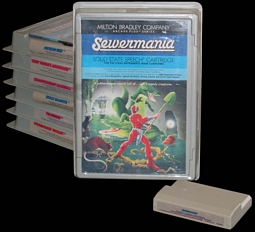 Championship Football Championship Tennis Green Muck Honey Hunt [click here for more info] I'm Hiding [click here for more info] Mail Drop Meteor Belt [click here for more info] Sewermania [click here for more info] Soundtrack Trolley [click here for more info] Space Bandits [click here for more info] Starship Pegasus [click here for more info] Superfly [click here for more info] Terry Turtle's Adventure [click here for more info]  FUN
BITS FUN
BITSHere's a little something extra that was received from Tim Scully, the programmer of Honey Hunt. This was a preliminary brochure from 1982 used to promote the up and coming MBX system. This is the only copy I have ever seen of this, so there must only be a handful out there. Note that the MBX it is called the Expander in this brochure and also sports a silver/black color scheme to match the silver/black consoles (it was never released in these colors). Also note that in the brochure's description for the video games it says you can flood the sewers in Sewermania to kill off the rats (this was removed in the released version due to the cartridge's memory limitations) and refers to I'm Hiding as Bug Hunt (the development name for the game). One other thing, the boy pictured on the front of this brochure and in the final MBX brochure is Stephen Langieri, the son of Mike Langieri who headed the MBX development. 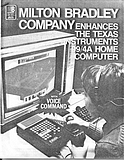 Click here to see the 1982 MBX Promotional
Brochure Click here to see the 1982 MBX Promotional
BrochureAs can be seen below, there are very few MBX websites out there (as of right now only 1). So hopefully both this page here at the TI-99/4A Videogame House and also Rob Patton's site can help fill the lack of information on this great video gaming system. ROB PATTON'S MBX PAGE Now here's a site that's been on the Internet for some time (since about 1996), and it's all dedicated to the MBX system for the TI-99/4A! There are some really great screen shots, reviews (be sure to check out the Championship Baseball review if you go there), cartridge/overlay images, and more. This site is highly recommended for anyone interested in reading up more on the MBX and all that it has to offer. |
|
|
||
|
|
TI-99/4A
Videogame House |
|